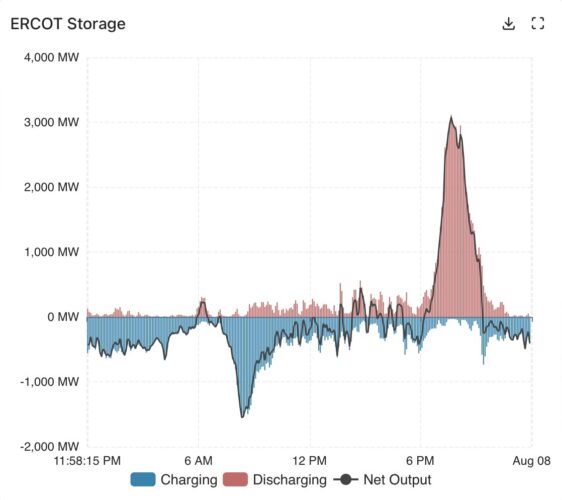Batteries step in as coal plant trips amid heatwave and near record demand in Texas

The Anemoi battery project in Texas. Image: Plus Power.
Giles Parkinson
Aug 9, 2024
2
Share via Email
Battery
Coal
The growing fleet of big batteries in Texas has stepped in to the market after another “always on” baseload power generator tripped in the middle of the evening peak, as the ongoing heatwaves pushed demand in the state towards record levels.
The culprit this time was a 550 megawatt coal unit. Last week it was a nuclear power plant. But the result was the same: Battery storage was able to respond in seconds and fill in the gap, underlying once again the importance of back-up power for any technology – be it fossil fuel, nuclear or renewable.
The coal unit on Wednesday (local time) tripped just after 6pm, as “net load” was starting to ramp up to meet the evening peak, just as residents returned home and switched on the air conditioning and other appliances for the evening meal.
The respond by the state’s growing fleet of big batteries produced a record for the local grid, called Ercot (the Electric Reliability Council of Texas), and reached 3,067 MW, the second highest discharge on record.

Source: Grid Status.
The role of battery storage is expected to increase significantly in coming years as Ercot commissions another 6 gigawatts of battery storage to reduce its reliance on gas and help the grid through the increasingly extreme weather conditions in both summer and winter.
The debate around energy choices in Australia – and other countries – has been hijacked by ideologues who like to pretend that neither coal nor nuclear require little or no backup, because the technologies are “baseload”, or “always on.”
But this is nonsense. Coal and nuclear plants are subject to unexpected trips, and because of their size this can be the most challenging part of managing the grid for the operators, as AEMO has made clear. They are also well aware that the sun rises and falls, and that wind speeds change, but these are largely predictable.
Ontario, the most nuclear dependent grid in the world after France with a more than 50 per cent share, has recently commissioned several gigawatts of new battery storage.
This is designed to help the speed of response in the case of trips from its ageing nuclear fleet, most of which will be offline for periods of three years or more at various times this decade for extensive and costly refurbishment programs, and to time shift excess nuclear output in the middle of the day to the evening peak when it is needed.
In Western Australia, big batteries are being commissioned to do exactly the same thing – in this case to time shift solar.
Share on Twitter Share on Facebook Share on Pinterest Share on LinkedIn Share on Reddit
reneweconomy.com.au |






